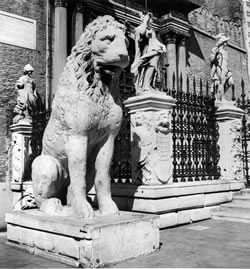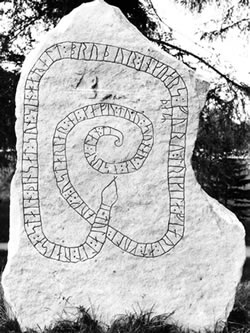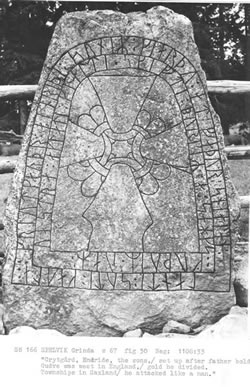The Raids
Frightened monks wrote the first descriptions of the Viking raids. Raiders struck like lightening from a clear sky, with nobody expecting them. Beginning in 789 with an attack by Norwegians on Portland, England, and followed in 793 with a raid on the monastery at Lindisfarne, the raids changed in character around 834. The first raids had been a quick series of summer attacks by Vikings who quickly turned home again in the fall. After that, the Vikings began gaining a foothold and came in large numbers, establishing permanent fortified camps to which they retreated in winter. In some of these raids territories were conquered, and the Vikings settled in, establishing political entities such as the Danelaw and Dublin.
The raids escalated in the 990s when the Norwegian king Olaf Tryggvason and the Danish king Svein Forkbeard assembled large armies to invade England. They were more interested in silver and other riches than territories and agreed to withdraw in return for payments in silver. Between 991 and 1012 the English paid nearly 67,000 kg of silver to keep the Norwegians and Danes at bay. In 1013, Svein Forkbeard conquered England. His son Canute the Great ruled England until his death in 1035. Sources on the raids include the Anglo-Saxon Chronicle, the Icelandic sagas, letters by the English cleric Alcuin (735-804), and a few short inscriptions on runestones refer to these events.
In France the Franks developed a useful tactic to protect themselves from the Viking attacks: they gave Normandy to the Norwegian chieftain Rollo in 911. In return, Rollo promised to protect them from further raids. Rollo is mentioned in the Icelandic Heimskringla and by the Norman historian Dudo of St. Quentin who was born around 965.
In eastern Europe, the Swedes traded more than they raided. Even so, they attempted an attack on Constantinople and plundered along the Dnieper as far away as the Caspian Sea. Silver was one of the attractions, but the Swedes and other Vikings were also actively involved in trading slaves, whom they obtained in raids.
Sources on the Rus [connection to Swedes] in Russia come from a variety of Greek and Arab manuscripts which have been transcribed and published and discussed over the past hundred years. One such source is De Administranrando Imperio (On the Administration of an Empire) by the Emperor Constantine Porphyrogenius, written about 950. The Russian Primary Chronicle tells of attacks and the establishment of a Swedish kingdom in Kiev. There are also a number of Arabic descriptions. You will see a couple of examples of such sources as well as read what the English, Irish and French had to say about the devastating raids in western Europe.



Chapters in Books
- John Marsden, [Symeon’s History of the Church of Durham c.1100 Cited in] Harassed by the Heathen Host, The Fury of the Northmen. Saints, Shrines and Sea-Raiders in the Viking Age AD 793-, 1993
- John Marsden, [Anglo-Saxon Chronicle c.793 Cited in] Such an Inroad from the Sea, The Fury of the Northmen. Saints, Shrines and Sea-Raiders in the Viking Age AD 793-, 1993
- John Marsden, [Symeon’s History of the Church of Durham c. 1100 Cited in] Such an Inroad from the Sea, The Fury of the Northmen. Saints, Shrines and Sea-Raiders in the Viking Age AD 793-, 1993
- John Marsden, [Byrtferth of Ramsey’s Historia Regum (History of the Kings) c.1000 Cited in] Such an Inroad from the Sea, The Fury of the Northmen. Saints, Shrines and Sea-Raiders in the Viking Age AD 793-, 1993
- Bernard Scudder, trans., [Going A-Viking in] Egil's Saga, The Sagas of Icelanders: A Selection, preface by Jane Smiley, introduction by Robert Kellogg, 2000
- Bernard Scudder, trans., [Raids in] Egil's Saga, The Sagas of Icelanders: A Selection, preface by Jane Smiley, introduction by Robert Kellogg, 2000

